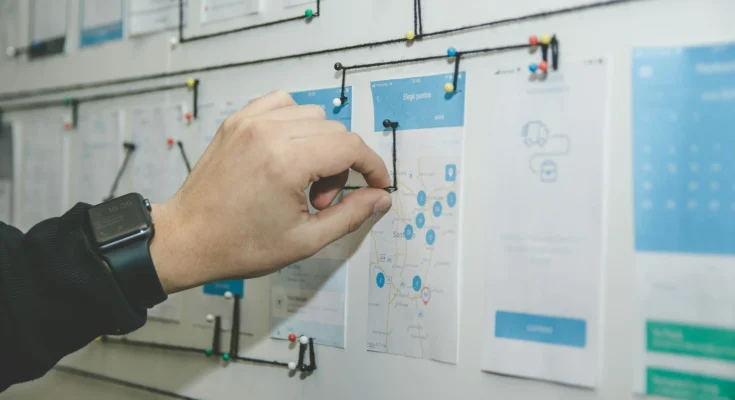Discover the key principles, best practices, and future trends in SaaS UX design to create exceptional user experiences.
Introduction to SaaS UX Design
The world of Software as a Service (SaaS) is rapidly expanding, offering innovative solutions that cater to a wide range of industries and user needs. A critical factor in the success of any SaaS product is its User Experience (UX) design. SaaS UX design focuses on crafting intuitive, efficient, and enjoyable experiences for users, ensuring that they can easily navigate and utilize the software’s features.
Importance of UX Design for SaaS
A well-designed UX can significantly impact a SaaS product’s success. UX design for SaaS plays a crucial role in:
Enhancing User Satisfaction: A seamless and intuitive user experience leads to higher satisfaction rates. Users are more likely to continue using and recommending a product that meets their needs effectively.
Boosting Conversion Rates: Effective UX design can guide users through the customer journey, reducing friction and increasing conversion rates. Clear calls to action (CTAs) and streamlined processes encourage users to complete desired actions, such as subscribing or purchasing.
Key Principles of SaaS UX Design
Understanding the core principles of SaaS UX design is essential for creating a user-friendly product:
Simplicity: Keep interfaces clean and straightforward. Overcomplicated designs can overwhelm users, leading to frustration and abandonment.
Consistency: Maintain a consistent design language across the product. Consistency in elements like buttons, icons, and navigation helps users understand and predict the system’s behavior.
Feedback and Response: Provide users with clear feedback for their actions. Whether it’s a simple hover effect, a loading spinner, or a success message, feedback helps users understand that their inputs have been received and processed.
Understanding SaaS UX Design Patterns
SaaS UX design patterns are recurring solutions that solve common design problems. These patterns streamline the design process and ensure a coherent user experience.
Common Patterns: Some frequently used patterns include navigation menus, modals, and form validations. Each pattern addresses a specific need, making it easier for users to interact with the product.
Benefits of Using Patterns: Implementing design patterns ensures consistency and efficiency. They provide a proven framework for solving common issues, reducing the need for custom solutions and extensive testing.

Best SaaS UX Design Practices
To create a standout best SaaS UX design, consider these practices:
User-Centered Design: Always prioritize the user’s needs and preferences. Conduct user research to understand pain points and tailor the design accordingly.
Mobile-First Approach: Design with mobile users in mind. As mobile usage continues to rise, ensuring a seamless experience across all devices is crucial.
A/B Testing: Regularly test different design elements to determine what works best. A/B testing provides data-driven insights into user preferences and behaviors.
Top SaaS UX Design Tools
Choosing the right tools can streamline the UX design process. Some of the best tools include:
Figma: Known for its collaborative features, Figma allows multiple designers to work on the same project simultaneously, making it ideal for team-based environments.
Sketch: Popular among macOS users, Sketch offers a robust set of features for creating detailed UI designs and prototypes.
Adobe XD: This tool provides a comprehensive platform for designing, prototyping, and sharing user experiences, with seamless integration with other Adobe products.
Case Studies of Best SaaS UX Design
Learning from successful SaaS products can provide valuable insights. Here are some examples of the best SaaS UX design:
Slack: Slack’s intuitive interface and seamless integration with various tools have set a high standard for SaaS UX design. Its focus on collaboration and ease of use has made it a favorite among users.
Trello: Trello’s visual task management system is a prime example of effective UX design. Its simple, drag-and-drop interface allows users to organize tasks effortlessly.
Zoom: Zoom’s straightforward design and reliable performance have made it a go-to solution for video conferencing. Its focus on ease of use and accessibility has driven widespread adoption.
Challenges in SaaS UX Design
Designing for SaaS presents unique challenges:
Scaling Design Systems: As SaaS products grow, maintaining a scalable and consistent design system becomes challenging. Designers must ensure that new features integrate seamlessly with the existing design.
Balancing Innovation with Usability: While innovation is essential, it must not come at the expense of usability. Striking the right balance ensures that new features enhance the user experience without causing confusion.
Future Trends in SaaS UX Design
The future of SaaS UX design is promising, with several trends set to shape the industry:
AI and Machine Learning Integration: Leveraging AI and machine learning can personalize user experiences and offer intelligent recommendations, enhancing overall satisfaction.
Personalization: Tailoring experiences to individual users’ needs and preferences will become increasingly important. Personalization can drive engagement and loyalty.
How to Conduct User Research for SaaS UX Design
Effective user research is the foundation of successful UX design:
Methods: Employ a variety of research methods, including surveys, interviews, and usability testing, to gather comprehensive insights into user behavior and preferences.
Analyzing Data: Analyze the collected data to identify patterns and pain points. Use these insights to inform design decisions and create user-centered solutions.
Role of User Feedback in SaaS UX Design
User feedback is invaluable for continuous improvement:
Collecting Feedback: Implement mechanisms for collecting user feedback, such as in-app surveys, feedback forms, and user interviews.
Implementing Changes: Act on the feedback received by making necessary adjustments to the design. This iterative process ensures that the product evolves to meet user needs.
Improving SaaS UX Through Iterative Design
Iterative design involves continuously refining the product based on user feedback and testing:
Prototyping: Create prototypes to visualize and test design ideas before full implementation. Prototyping helps identify potential issues early in the design process.
Usability Testing: Conduct usability tests to evaluate the product’s performance. Use the results to make informed improvements and ensure a seamless user experience.
SaaS UX Design for Different User Types
SaaS products often cater to diverse user groups. Designing for different user types ensures inclusivity:
Admins: Focus on providing comprehensive control and management features that streamline administrative tasks.
End-Users: Design with simplicity and ease of use in mind, ensuring that end-users can navigate and utilize the product without extensive training.
Developers: Offer robust APIs and customization options to empower developers to integrate and extend the product’s functionality.
Building a SaaS UX Design System
A design system provides a cohesive framework for maintaining consistency across the product:
Components: Define reusable components, such as buttons, forms, and icons, to ensure a unified look and feel.
Guidelines: Establish design guidelines that outline best practices and standards for using components and creating new ones.
Documentation: Provide detailed documentation to guide designers and developers in implementing the design system effectively.
UX Design for SaaS Onboarding
Onboarding is a critical phase for user retention:
Simplifying Onboarding: Break down the onboarding process into manageable steps. Provide clear instructions and tooltips to guide users through the initial setup.
Gamification Techniques: Use gamification elements, such as progress bars and rewards, to engage users and make the onboarding process enjoyable.
Integrating SaaS UX Design with Marketing
A seamless integration between UX design and marketing efforts can enhance the overall user experience:
Branding: Ensure that the UX design aligns with the brand’s identity. Consistent branding reinforces trust and recognition.
Customer Journey Mapping: Map out the customer journey to identify touchpoints where UX design can support marketing efforts. Optimize these touchpoints to improve engagement and conversion rates.
Common Mistakes in SaaS UX Design
Avoiding common pitfalls can lead to better design outcomes:
Ignoring User Feedback: Neglecting user feedback can result in a product that fails to meet user needs. Continuously gather and act on feedback to ensure relevance.
Overcomplicating Features: Adding too many features can overwhelm users. Focus on essential functionalities and provide a clear, intuitive interface.
Optimizing SaaS UX Design for Conversion
Effective UX design can drive conversions and business growth:
Call to Actions (CTAs): Design prominent and compelling CTAs that guide users toward desired actions. Use contrasting colors and clear messaging to make CTAs stand out.
Landing Page Design: Optimize landing pages to provide a clear value proposition and guide users toward conversion. Use persuasive design elements and concise, impactful content.
Measuring the Success of SaaS UX Design
Tracking and measuring the impact of UX design is crucial for continuous improvement:
Key Performance Indicators (KPIs): Define KPIs such as user engagement, conversion rates, and task completion rates to evaluate UX performance.
Tools and Techniques: Utilize tools like Google Analytics, heatmaps, and user feedback platforms to gather data and assess the effectiveness of UX design.
SaaS UX Design for Accessibility
Accessibility ensures that all users can interact with the product, regardless of their abilities:
Inclusive Design: Design with inclusivity in mind by considering the diverse needs of users. Implement features like keyboard navigation and screen reader compatibility.
Compliance with Standards: Adhere to accessibility standards, such as WCAG (Web Content Accessibility Guidelines), to ensure legal compliance and provide a better user experience.
Cost-Effective SaaS UX Design Strategies
Effective UX design doesn’t always require a large budget:
Open-Source Tools: Leverage open-source design tools to reduce costs while maintaining quality.
Lean UX: Implement lean UX practices that focus on delivering value quickly and efficiently. This approach emphasizes rapid prototyping and iterative testing.
UX Design for SaaS Security and Privacy
Ensuring security and privacy is critical for building user trust:
Ensuring Data Protection: Implement robust security measures to protect user data from breaches and unauthorized access.
User Trust: Clearly communicate security and privacy policies to users. Transparency in handling user data fosters trust and confidence.
Collaborative SaaS UX Design Process
Collaboration is key to successful UX design:
Working with Stakeholders: Involve stakeholders from various departments, such as product management, development, and marketing, to gather diverse perspectives and ensure alignment.
Agile Methodologies: Adopt agile methodologies to facilitate collaboration and iterative development. Regular feedback loops and cross-functional teams can enhance the design process.
Localization in SaaS UX Design
Adapting the UX design for different markets can improve user engagement:
Adapting for Different Markets: Customize the design to cater to the cultural and linguistic preferences of different user groups.
Cultural Sensitivity: Be mindful of cultural differences and design elements that may have different interpretations across regions.
Best SaaS UX Design Courses and Resources
Continuous learning is essential for staying updated with the latest trends and techniques:
Online Courses: Platforms like Coursera, Udemy, and LinkedIn Learning offer courses on SaaS UX design, covering both foundational and advanced topics.
Books: Recommended books include “Don’t Make Me Think” by Steve Krug and “The Design of Everyday Things” by Don Norman.
Communities: Join design communities and forums, such as Dribbble, Behance, and UX Design Community, to network with other designers and share insights.
Customizing SaaS UX for Enterprise Solutions
Designing for enterprise solutions requires addressing complex workflows and scalability:
Handling Complex Workflows: Ensure that the design supports complex workflows typical of enterprise environments. Provide advanced features and customization options to meet diverse needs.
Scalability: Design with scalability in mind to accommodate growing user bases and expanding functionalities.
Maintaining Consistency in SaaS UX Design
Consistency is key to a cohesive user experience:
Design Systems: Implement a design system to maintain visual and functional consistency across the product.
Style Guides: Create comprehensive style guides that outline design principles, color palettes, typography, and component usage.
Building SaaS UX Design Portfolio
Showcasing your work effectively can attract potential clients and employers:
Showcasing Work: Highlight key projects and provide detailed case studies that demonstrate your design process and impact.
Gaining Clients: Use your portfolio to showcase your expertise and attract potential clients. Include testimonials and measurable outcomes to build credibility.
The Role of Typography in SaaS UX Design
Typography plays a crucial role in readability and brand identity:
Readability: Choose fonts that enhance readability, especially for long-form content and complex interfaces.
Brand Identity: Ensure that the typography aligns with the brand’s identity. Consistent use of typography reinforces brand recognition and trust.
Using Animation in SaaS UX Design
Animation can enhance the user experience by providing visual feedback and engaging interactions:
Enhancing User Experience: Use animations to guide users through tasks, highlight important information, and provide feedback for their actions.
Providing Visual Feedback: Subtle animations can indicate that an action is being processed, reducing user frustration and improving perceived performance.
Conclusion
Creating an exceptional SaaS UX design requires a deep understanding of user needs, a commitment to continuous improvement, and the ability to balance innovation with usability. By following best practices, leveraging design patterns, and staying informed about industry trends, designers can craft SaaS products that offer outstanding user experiences and drive business success.
FAQs
What are the key principles of SaaS UX design?
Key principles include simplicity, consistency, and providing clear feedback to users for their actions.
How can user feedback improve SaaS UX design?
Collecting and implementing user feedback helps ensure the product meets user needs and continuously improves.
What are some common SaaS UX design patterns?
Common patterns include navigation menus, modals, and form validations, which address specific design needs and enhance usability.
Why is mobile-first design important for SaaS UX?
With the increasing use of mobile devices, a mobile-first approach ensures a seamless user experience across all devices.
How can SaaS UX design improve conversion rates?
Effective UX design can reduce friction, guide users through the customer journey, and encourage desired actions, such as subscribing or purchasing.
What tools are best for SaaS UX design?
Top tools include Figma, Sketch, and Adobe XD, each offering unique features for designing and prototyping user experiences.




